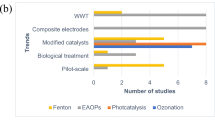Abstract
Improved environmental performance continues to grow in importance to industry. We have been examining thermal and photochemical oxidation processes for the treatment of dilute aqueous organic wastes that are either generated in the course of chemical manufacturing or exist in contaminated groundwaters. Most of our work has focused on advanced oxidation processes1 which employ oxidants and catalysts and depend to some degree on the in-situ generation of hydroxyl radicals (OH). Our program has involved: a) laboratory and treatability studies on model and actual wastewaters that compare chemical oxidation technologies, explore oxidation mechanisms, and utilize experimental designs aimed at delineating important parameters; b) pilot-scale field demonstrations on industrial streams and c) economic and engineering evaluations including comparisons with base technologies such as carbon adsorption and air or stream stripping/abatement. We have examined Fenton oxidation (Fe/H2O2), UV photochemical oxidation (UV/H2O2, UV/Fe/H2O2 and UV/ozone) and semiconductor (TiO2) photocatalytic oxidation. Herein, we report on our investigations of the photochemically driven oxidation of a number of model aromatic wastes using iron catalysts, hydrogen peroxide, and oxygen. The goal of this work is to compare relative efficiencies of destruction, delineate the important factors that control destruction efficiencies and elucidate reaction mechanisms. We have chosen to focus on aromatic compounds because they react rapidly with hydroxyl radicals2 and also have uv absorptions which allow one to follow the course of their disappearance.
Access this chapter
Tax calculation will be finalised at checkout
Purchases are for personal use only
Preview
Unable to display preview. Download preview PDF.
Similar content being viewed by others
References
ACS Symposium Series 422, “Emerging Technologies in Hazardous Waste Management,” D.W. Tedder, ed., ACS Publications. 1989.
P. Jackman and R.L. Powell, “Hazardous Waste Treatment Technologies,” Noyes Publications, Park Ridge, NJ, 1991.
W.R. Haag and C.C.D. Yao, Rate constants for reaction of hydroxyl radicals with several drinking water contaminants, Environ. Sci. Technol. 26:1005 (1992)
Reference lb, p. 79.
“Handbook of Chemistry and Physics,” 41st Ed., C.D. Hodgman, ed., Chemical Rubber Pub. Co., Cleveland, 1959–60, pp. 1913–1921.
J.W.T. Spinks and R.J.J. Woods, “An Introduction to Radiation Chemistry,” John Wiley & Sons, New York, 1964.
C.A. Tolman, W. Tumas, S.Y.L. Lee, and D. Campos, The destruction of phenol in dilute aqueous solution by H2O2/Fe++/uv/O2, presented at the Symposium on Emerging Technologies for Hazardous Waste Management ,Atlanta, Sept. 21–23, 1992, and submitted for publication in the “A.C.S. Symposium Series.”
J.J. Pignatello, Dark and photoassisted Fe3+-catalyzed degradation of chlorophenoxy herbicides by hydrogen peroxide, Environ. Sci. Technol. 26:944 (1992).
N.J. Turro, “Modern Molecular Photchemistry,” Benjamin Cummings Publishing Co., Inc., Menlo Park, CA, 1978, pp. 528 and 368.
K. Ohkubo, Y. Arikawa and S. Sakaki, Iron(III)-catalyzed photo-hydroxylation of benzene in aqueous solution with and without ionic or neutral surfactants, J. Mol. Cat. 26:139 (1984).
R.G. Zepp, B.C. Faust and J. Hoigne, Hydroxyl radical formation in aqueous reactions (pH 3-8) of iron(II) with hydrogen peroxide: the photo-Fenton reaction, Environ. Sci. Technol. 26:313 (1992).
Y. Zuo and J. Hoigne, Formation of hydrogen peroxide and depletion of oxalic acid in atmospheric water by photolysis of Iron(III)-oxalato complexes, Environ. Sci. Technol. 26:1014 (1992).
C.T. Mathews and R.G. Robbins, The oxidation of aqueous ferrous sulphate solutions by molecular oxygen, Proc. Aust. Inst. Min. Met. ,242:47 (1972).
Symposium on Environmental Applications of Advanced Oxidation Technologies ,sponsored by the Electric Power Research Institute and the National Science Foundation, San Francisco, Feb. 22–24, 1993.
Author information
Authors and Affiliations
Editor information
Editors and Affiliations
Rights and permissions
Copyright information
© 1993 Springer Science+Business Media New York
About this chapter
Cite this chapter
Tolman, C.A., Tumas, W., Lee, S.Y.L., Campos, D. (1993). The Destruction of Toxic Aqueous Organic Compounds by H2O2/Fe++/UV/O2 . In: Barton, D.H.R., Martell, A.E., Sawyer, D.T. (eds) The Activation of Dioxygen and Homogeneous Catalytic Oxidation. Springer, Boston, MA. https://doi.org/10.1007/978-1-4615-3000-8_5
Download citation
DOI: https://doi.org/10.1007/978-1-4615-3000-8_5
Publisher Name: Springer, Boston, MA
Print ISBN: 978-1-4613-6307-1
Online ISBN: 978-1-4615-3000-8
eBook Packages: Springer Book Archive




